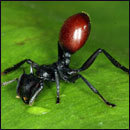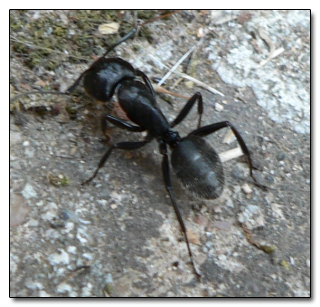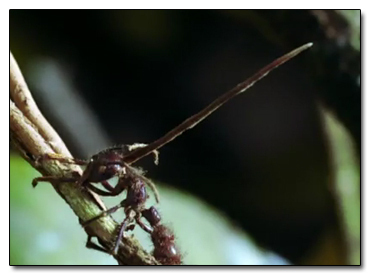The 5 Creepiest Ways Animals Have Mastered Mind Control

Humans have been trying to control each other's minds for centuries, but have only succeeded in getting people to buy more tortilla chips and hand cream. Meanwhile, in the animal kingdom, absurd comic-book style mind-control plots have been coming true for millennia.
Glyptapanteles (Zombie-Caterpillar-Creating Wasps)

Wasps are horrible, awful, pointless creatures, and we hate them. If you want to go tell them we said that, go ahead. We don't care. But some of them are inexplicably worse than others: Enter the Glyptapanteles. These wasps are not content to sting and kill their prey (in this case, the gypsy moth caterpillar), but actually inject their eggs inside of the victim's body. So their victims aren't just killed and eaten, but are first impregnated via interspecies wasp-rape. And yes, did you even need to ask? Of course the wasp babies eat the caterpillars from inside.

They eat them from inside like crazy.
And yet, still, the caterpillars do not die (though there is some rigorous scientific debate as to whether or not a caterpillar can beg for the sweet release of death; we are going to assume they do so incessantly from this point forward). Some of the larva hatch and burrow out of the caterpillar's skin, sure, and that's horrible, but others stay behind ... to take control of its brain. The mind-controlling pupa inside manipulate the caterpillar into standing guard and protecting their vulnerable brethren outside, occasionally even forcing it to spin protective silk over them. So the caterpillar not only gets stung, raped and hollowed out, but also actually has to sit there and guard its attackers against all predators (by thrashing around like a spaz if anybody comes near).

Above: Insect judo.
There's just ... there's no way this is the most effective way to procreate, right? At least some element of that whole procedure -- the spaz-thrashing, for example -- simply has to be for pure and simple spite.

You can almost hear it scream.
Cordyceps Unilateralis (Zombie-Ant-Creating Fungus)

So a particular species of carpenter ant, Camponotus leonardi, is going about its daily business -- carrying food, making piles, lifting, what have you -- when it accidentally inhales a spore. Now, inhaling a spore never ends in a pizza party and a trip to Sea World; it's pretty much always horror and death. And the spores of Cordyceps unilateralis are no different.

Above: A carpenter ant, blissfully unaware of the doom that awaits it.
The fungus begins by consuming "the non-vital soft tissues" of the ant -- while it's still alive, of course. (Actually, since that's the most horrifying scenario possible, let's go ahead and assume that everything is devoured alive from here on out. Saves time that way). Then the fungus uses those nutrients to sprout mycelia (that's science-speak for "horrible mold tentacles") up into the brain of the ant. There, the mycelia actually change the way the ant perceives pheromones in order to manipulate the insect into the fungus' desired position. And the fungus has a very specific list of conditions: It requires a north-facing leaf of a plant about 25 centimeters off the ground, in an environment with 94 to 95 percent humidity and a location with temperatures between 20 to 30 degrees Celsius. And it gets it.

"I have no mandibles, yet I must scream."
That's how precise the control of the fungus is: It can navigate an ant to the absolute perfect location, down to a single percentage point of humidity.
Only there, finally, is the ant allowed to die. After setting up shop and fortifying the ant's corpse to allow for safe growth, the fruiting body of the fungus eventually explodes out of the back of the ant's head, shooting its sporey load onto the forest floor ... where there are thousands of unexploded ant heads just waiting to inhale more spores.

The Thing doesn't have shit on Mother Nature.
Jesus, is there any point to that, aside from 'fuck ants'? It's like some advanced alien race with access to terrifying biological weapons had a picnic ruined ten thousand years ago and just cannot let it go.
Spiny-Headed Worms (Masters of the Suicidal Pill Bug)

The spiny-headed worm lives its entire adult life with its spiny head stuck to the inside of the gut of a starling. And that's kind of messed up, but it's not exactly burrowing into the starling's brain to make it do an embarrassing tap routine, so let's just call that a win for the bird kingdom. And hey, if Mr. McSpiny meets a lovely lady and wants to settle down and have children in the bird's guts, well, at least it hasn't turned the bird's skull into a spore cannon. So go nuts, you crazy worms.

Oh yeah. This is ... this is totally cool.
End scene.
Exterior: Forest floor.
A cute little pudgy pill bug is minding his own business, sitting in some dark, damp leaf litter (he really likes the dark and damp). Then he happens upon some starling poop, which, being a stupid bug without access to burritos, he decides to eat. Delectable. A deep earthy flavor with sharp notes of digested earthworms hits the back of his pill bug palate to his roly poly delight. But there's something wrong, there's something just a little off about this bird shit in his mouth. What could it be?

Fennel?
Why, eggs, of course.
Mr. Pill Bug has just been unwittingly impregnated by baby hellraiser worms. He goes about his pill bug life for a while, probably rolling down hills with his children and building a little burrow for his pill bug wife, thinking that everything is fine. He forgets that there are demons growing inside of him. Everything is hunky dory, until one day, instead of hiding under a rock like he's been doing his whole life, he has an inescapable urge to run out into the open sun.
A hungry bird happens by, notices the unusually exposed and jaunty pill bug, and picks up an easy meal. Tiny pill bug children cry themselves to sleep at home. Mrs. Pill Bug starts turning tricks just to keep the rent paid.

And the starling spends the rest of its life with a permanent case of the shits.
And all this because the worms had simply outgrown their tiny little host and wanted something a little more spacious, with a bit of flair; modest, but definitely stylish -- a starling, perhaps? But instead of hiring some movers and checking parasitical Craigslist (it's kind of like regular Craigslist except ... uh ... no, never mind; it's exactly like regular Craigslist), the worms move house by invading the pill bug's brain and altering its chemistry to make the normally shade-loving creatures attracted to light. Defying every instinct they have, the pill bugs are brainwashed into direct sunlight -- and certain death -- by the mind-controlling parasites within.

"And you thought only vertebrates could be supervillains."
Acacia Tree (How to Make Your Own Defending Army)

For decades, scientists thought that the acacia tree had a beautiful and beneficial partnership with a certain species of guard ant: The ants get to eat the sugary plant nectar and live in special hollowed-out thorns that provide safety, and in turn, they defend their kindly plant host from predators. But recently, researchers found that's not the whole story -- the nectar the plant produces isn't just sweet, it's like a drug that turns ants into an army of desperate addicts. And that's not all the acacia tree produces: It also secretes the single most effective ant repellent in the region. By providing or withholding one or the other substance, the acacia tree actually steers the ants around -- toward areas that need defending, or away from tender flowers during pollinating season -- with a combination of drug cocktails and ant-crack.

"Wanna buy a dimebag?"
That's right: This tree has specific wants and needs, and it somehow communicates those to its ant-addict commandos. If you're a plant competing for sunlight, the ants cut off your leaves; if you're a stem-boring beetle, get ready for an ant battle.

This makes the junkie flinging poop at a SWAT team look kind of lazy.
Sometimes even giraffes come for the acacia leaves. But the immense, ridiculous size difference is not enough to deter the ant hordes: If that giraffe steps to the wrong tree, the zombie ants attack, stinging and biting its face until it is forced to flee. As desperate as you think human addiction might be, ant addiction is a whole other bag (not many crackheads would happily fistfight something 10 times the size of Godzilla for another rock).

"Say hello to my even littler friend."
Myrmeconema Neotropicum (Berry-Imitating-Zombie-Ant-Creating Roundworms)

There's a species of badass "gliding" ants known as Cephalotes atratus that leap from trees and actually parachute down in controlled falls. These sweet-ass paratrooper ants, unfortunately, survive largely on bird feces ... presumably because they haven't read this article on the anternet yet (that was for you, ants with terrible taste in jokes). To the surprise of nobody, the ants are frequently infested with a parasitic roundworm called Myrmeconema neotropicum.

Otherwise known as "the mother of all fire holes."
The roundworms eventually need to get all up inside a bird to complete their life cycle, which means, as you could have probably guessed, that some terrifying shit is about to go down in Antworld. But first, the roundworms have a problem: They can't just steer these ants in front of predators -- the ants don't like being devoured by birds (go figure) and so have evolved a number of chemical defenses to keep things from ingesting them. Long story short: They smell and taste horrible.
So the roundworm geniuses at the Polytechnic Institute of Parasitic Dickholes came up with a brilliant plan to get around those defenses: First, they infest the ant's, ah, rear parts, making it swell and turn bright red. The idea is to make the insect look like something a bird would want. In this case, a delicious kind of berry (presumably the unfortunately shaped, but nonetheless delectable, Ant-Ass Berry). The roundworms then somehow take control of their host and force the ant to hustle on up the forest canopy and show off that sexy berry-rump to passersby. The ants actually assume an 'eat-me' position: Head down, bright red ass in the air. If a near-sighted bird in a hurry needs some avian version of fast food and takes the bait, it gets not only a nasty surprise in the form of a mouthful of chemically defended ant-butt, but also a colony of parasites nesting in its guts.

It gives a whole new meaning to the term "dingleberry."
So basically, it's no different from regular fast food.
For more reasons to fear Mother Nature, check out Nature's 6 Most Diabolical Predators and The 6 Most Insane Sex Lives in the Animal Kingdom.
And stop by LinkSTORM to read more about the Animal Apocalypse.
And don't forget to follow us on Facebook and Twitter to get sexy, sexy jokes sent straight to your news feed.
Do you have an idea in mind that would make a great article? Then sign up for our writers workshop! Do you possess expert skills in image creation and manipulation? Mediocre? Even rudimentary? Are you frightened by MS Paint and simply have a funny idea? You can create an infograpic and you could be on the front page of Cracked.com tomorrow!